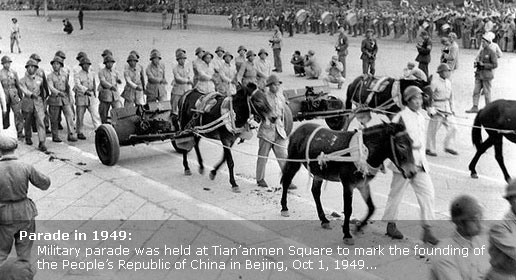60 People, 60 Stories
Tech conglomerate riding 'green' wave
(China Daily)
Updated: 2009-09-30 07:41
Jim Gradoville first came to China on a winter day in 1983. His first impression was that "everything was blue and grey".
|
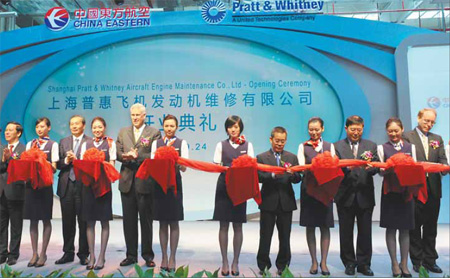 United Technologies Corp CEO and President Louis Chênevert (center) at the inauguration ceremony for new aircraft engine maintenance joint venture in Shanghai in which the company has a 49 percent stake. [China Daily] |
"But there have been dramatic changes in the country," said Gradoville, president of United Technologies Corp (UTC) International Operations for China.
Gradoville took the position as head of UTC's China branch four years ago.
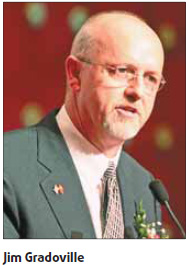
"I dare say that China is now our most important market outside our home market the US," he said.
With headquarters in Hartford, Connecticut, UTC is now one of the largest international investors in China. The company's Otis elevators and Carrier air conditioners are market leaders in the country.
All of UTC's subsidiaries have now entered China, including Carrier air conditioning systems, Hamilton Sundstrand aerospace, Otis elevators, Pratt & Whitney aircraft engines, Sikorsky helicopters, UTC Fire & Security, UTC Power and United Technologies Research Center. The company has more than 40 joint ventures in China employing over 16,000 people.
Although sales revenue from China still accounts for less than 10 percent of the company's global total, the market has "the fastest growth rate and biggest potential in the future", said Gradoville.
UTC's revenue in China was 12.2 billion yuan in 2004, which increased to 19.3 billion yuan last year, he added.
UTC is "in a good position" in China's building and aviation industries, Gradoville said.
Construction has boomed, while the country's aviation industry is growing by 15 percent annually. The two sectors will offer UTC huge opportunities in the future, he said.
Green business
On September 24, UTC company Pratt & Whitney and its joint venture partner China Eastern Airlines opened an engine overhaul facility in Shanghai.
The Shanghai engine center has an annual overhaul capacity up to 300 engines, with nearly 100 engines expected to be overhauled next year. Within three years, the center will service CFM56-3, 5B and 7 engines and employ 800 people.
The building was designed and built to meet the US Green Building Council's Leadership in Energy and Environmental Design (LEED) "platinum standards". The LEED rating system is a widely accepted benchmark for design, construction and operation of high performance green buildings.
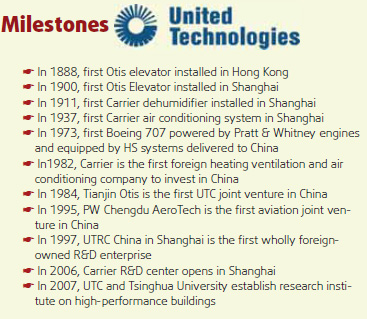
"UTC not only provides green products and green solutions, every single facility under us has a mandate to be designed with energy efficiency and environmental sustainability mind," said Gradoville.
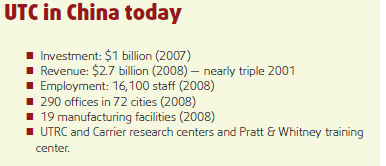
One example is the Otis Elevator Co TEDA Center office and plant in Tianjin that have been awarded "gold" LEED certification due to technologies incorporated in the building that reduce energy use at least 25 percent.
The office building has an extensively insulated and reflective roof to reduce heat island effects, high-performance lighting equipment, radiant heating and a demand-controlled ventilation system with CO2 sensors to ensure a quality indoor environment.
As the first UTC facility to earn LEED "gold" recognition, the building has an Otis energy-efficient GEN-2 elevator system with heating, ventilating, air conditioning and building automation systems from UTC's Carrier business unit, as well as security and access systems from UTC Fire & Security.
UTC's green products have been used in big projects in China, including three of the Shanghai 2010 World Expo's five permanent venues - Expo Boulevard, World Expo Center and Theme Pavilions have Carrier building solutions. Otis has won contracts to supply and install 151 elevators including its energy efficient GEN-2 elevators for the event.
Carrier's innovations include river source heat exchange systems, ice storage technology, chilled water storage technology, efficient variable frequency centrifugal chillers and air-cooled screw heat pumps. They address demands for non-ozone depleting, energy efficient and cost-effective operations in Expo venues.
"There has been growing consensus that green technology will bring us a great future, and it is the thing UTC has been doing for a long time," said Gradoville.
Eco-city
Gradoville told China Daily that since 1997 UTC has reduced its base energy consumption by 22 percent while doubling revenues.
"Green means continually increased efficiencies in both operations and products, and we don't see any end in sight."
The company's latest environmental goals released in 2007 include a 12 percent reduction in greenhouse gas emissions by the end of 2010, or 3 percent annually.
Water consumption is targeted for a 2.5 percent annual reduction
"We've had fast starts on both since 2007, reducing greenhouse gas emissions and water by 11 percent," said Gradoville.
In July 2009 UTC signed an agreement with the Chinese Society for Urban Studies under the Ministry of Housing and Urban Rural Development under which both parties will guide and measure China's eco-city planning and development and publish best practices.
Today, China's eco-city model is still under development, so a gap exists between theoretical study and practical application.
The study of eco-cities in China is now mainly focused on discussion of connotation, planning, design principles and methodology, with attention also given to an eco-city index system to compare different approaches and results, said Gradoville.
Such a scientific index system to evaluate relative eco-city development is needed by both central and local decision makers and the public to better understand and monitor the latest urban models, he said.
Healthy urbanization and sustainable development will become priorities in economic and social development that need urgent study by governments at all levels, he added.






